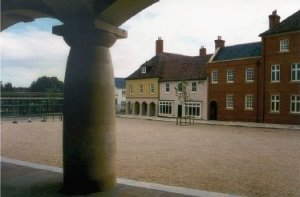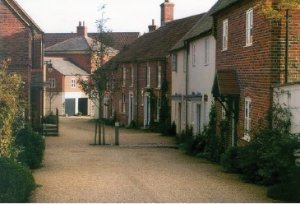Visit to Poundbury - TrustNews December 08
Members of the Trust visited Poundbury, the major new extension being built in Dorchester, on 9th September, when we were shown round by the development manager, Simon Conibear. The weather was atrocious, but the group was nevertheless grateful to Mr Conibear for his excellent talk and guided tour. Poundbury is being built on Duchy of Cornwall land, and its design is therefore strongly influenced by the Prince of Wales' views on architecture and town planning. It is to be built in four phases over the next twelve years, according to market demand for housing. The first phase is complete with about 1,500 people living in it, and work has begun on the second phase.

The Village Square Poundbury
Many members will know that private housing at Poundbury is built in traditional vernacular style, and will no doubt have their own views on that. The Trust broadly considers that style is a matter of personal taste, and what matters is that buildings should be well designed in whatever style is chosen. This writer found that the cottage style of the private housing was too sentimental for his taste; however it was the public buildings that were really bizarre – the village hall for example is built on strange, somewhat Egyptian columns, and has large, rather Germanic dormers. What a good idea to build a village hall on columns as in the Cotswolds, giving covered open pace below; but why the weird mannerist style?

Housing in the vernacular style
Be that as it may, what really impresses about Poundbury is the quality of the town planning. The Prince of Wales appointed Leon Krier to produce a master plan, and the quality that results from following a plan shows. It is in many ways a textbook of many points that the Trust advocates: mixed use of public spaces, the elimination of pavements, traffic calming by the clever use of turns, informal supervision of public space, the disguising of car parking areas, and the removal of through traffic, for example. The Trust has been urging our City Council to undertake such an exercise in Winchester before deciding where any new housing should be built. Poundbury shows why that is important.
